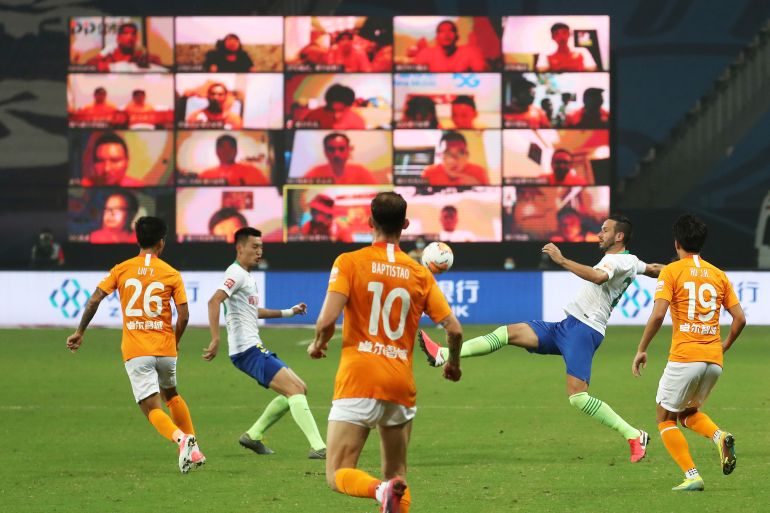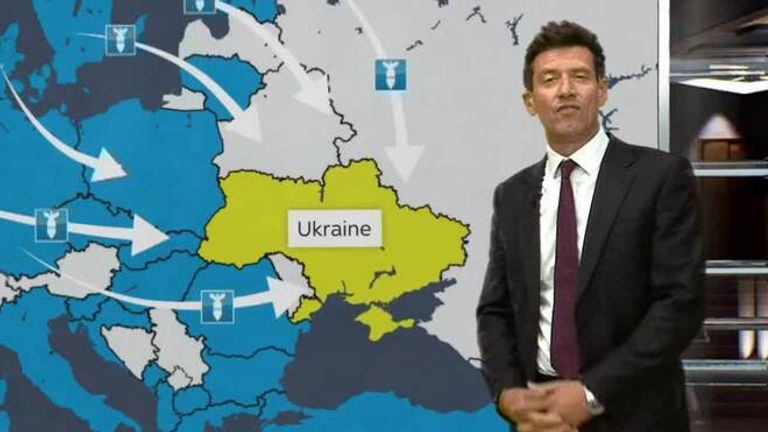After years of crisis, can China revive its lofty football goals?
President Xi wants China to become a top footballing global force by 2050. But, with a new season about to kick off, the Chinese game is in the doldrums.

A year before the ardent football fan Xi Jinping became China’s president, he had already made it clear that decades of underachievement in the sport by the world’s most populous country had to end.
In 2011, Xi told a politician from South Korea, a much smaller neighbour with a much better footballing record, that he had three wishes: for China to qualify for the World Cup for the first time since its 2002 debut, then to host the tournament and, eventually, to win it.
A detailed plan was announced in 2016 that set a target for China to become a top Asian football power by 2030 and a leading global force by 2050.
Football has not been a recent priority for Xi, who has had more pressing issues to deal with.
Long after the rest of the world emerged from the global pandemic, the president’s “zero-COVID” policy – aimed at stamping out the virus, rather than living with it – meant imposing some of the world’s most restrictive lockdowns. The economy has also suffered a sharp downturn in recent years and football has been hit by a series of corruption allegations.
It has left Chinese football firmly in the doldrums.
“No one mentions football superpower ambitions or long-term goals any more after tumultuous years in which COVID was not the only problem,” Bi Yuan, a Beijing-based sports consultant, told Al Jazeera.
With China finally reopening its economy and borders as 2022 came to a close, and the new Chinese Super League (CSL) season kicking off on Saturday, some are wondering if the plans to make China a football superpower can be dusted off.
More than $1bn was spent in the previous decade on foreign stars such as Didier Drogba, Carlos Tevez and Nicolas Anelka and big-name coaches such as Marcello Lippi, Luiz Felipe Scolari and Fabio Capello as CSL became a major destination outside the big European leagues.
It culminated in the December-January transfer window of 2016-17 when CSL clubs spent about $400m on new signings, more than any other league in the world. Its profile had never been higher. But authorities in Beijing, concerned at the amounts being spent, introduced transfer taxes and salary caps.
Debts caused by spending were soon compounded by wider economic woes.
More than half of the top-tier teams were owned by property developers who ploughed money into their clubs, hoping to gain political advantages from closer relations with regional or national authorities.
Towards the end of the last decade, a slowdown in an overheated real estate market was starting to hit the bottom lines of many of these companies. Then the arrival of COVID was devastating.
Since the end of 2019, games were played in mostly empty stadiums in centralised venues, hitting income from broadcasting and sponsorship.
In 2021, champions Jiangsu FC folded after its owners pulled their investment from the club. Other clubs such as Chongqing and Hebei struggled to pay players. Guangzhou FC, owned by debt-ridden Evergrande, whose investment brought eight Chinese titles and two Asian champions from 2011 to 2019, were relegated in December.
In March, eight clubs from the top three tiers – including Guangzhou City from the CSL – were disqualified from their leagues for various financial issues as the Chinese Football Association (CFA) looked to clean house.
Meanwhile, the CFA was also rocked by strife. In February, CFA president Chen Xuyuan was arrested on corruption charges. Other officials are also reportedly under investigation for “serious violations of laws”, including former national team coach Li Tie.
Amid the crises afflicting the sport, Chinese clubs have floundered in recent continental competitions and a dismal Qatar 2022 World Cup qualification campaign saw the national team win just once in 10 games in the final round.
Many have also pointed to the longstanding failure to develop high-quality young Chinese players.
“Pre-pandemic, the authorities had already figured out that a focus on the long-term development of domestic talent is important, rather than buying expensive overseas stars,” Simon Chadwick, professor of sport and geopolitical economy at SKEMA Business School, told Al Jazeera.
Chen Xuyuan summed it up in 2020.
“The expenditure of Chinese Super League clubs is about 10 times higher than South Korea’s K-League and three times higher than Japan’s J-League,” he said. “But our national team is lagging far behind.”
Tom Byer, an American coach now based in Japan, was hired by the CFA in 2013 to help Chinese football build stronger and deeper foundations.
“The main strategy for Chinese football was implementing football throughout the schools,” he told Al Jazeera.
He designed the technical curriculum for a programme aiming to create 50,000 football schools by 2025, spanning first grade right up to universities.
“The biggest thing that stood out to me during my work for several years in China was the investment that went into education. The facilities at the school football programme schools are outstanding – much better than Japanese schools,” he said.
He says much of the good work has since been undone.
“It’s been halted for the past few years,” said Byer. “Funding had been pulled along with the restrictions on people gathering.”
There is one silver lining. With less reliance on foreign players, there are now more opportunities for young domestic players as clubs have little choice to play them.
Guangzhou FC, for example, fielded a team full of young local players last season.
Regardless of who is wearing the shirt, there is a hunger among fans to get back into stadiums once the new season starts on Saturday.
“Overall, Chinese fans are feeling relieved,” said Bi “After a time without hope, there is now something to look forward to.”
The return of fans also spells good news for struggling clubs.
“It will help create conditions in which Chinese football can start to get back to where it was pre-pandemic,” said Chadwick. “People will be able to attend matches in large numbers and move around the country, which will have a tangible impact upon the likes of pre-match entertainment and football shirt sales.”
But the late announcement of the new season, coming just a week before it kicks off, has given clubs little time to organise tickets and they are scrambling to secure players.
“The country and its officials now need to redouble their efforts if China is to become a leading FIFA nation by 2050,” said Chadwick.
-al jazeera







